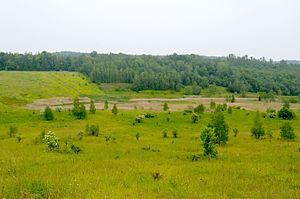Haverlahwiese opencast mine
|
Haverlahwiese opencast mine
|
||
| location | Southwest of Salzgitter | |
| surface | 206 hectares | |
| Identifier | NSG BR 149 | |
| WDPA ID | 555519157 | |
| Geographical location | 52 ° 6 ' N , 10 ° 19' E | |
|
|
||
| Sea level | from 165 m to 240 m | |
| Setup date | June 30, 2016 | |
| administration | NLWKN | |
The Haverlahwiese opencast mine is a nature reserve in the Lower Saxony city of Salzgitter .
The nature reserve with the registration NSG BR 149 is around 206 hectares . It is largely congruent with the 116.7 hectare FFH area “Kammmolch-Biotope Haverlahwiese opencast mine”. The protected area is up to a strip in the west from the conservation area "forest belt between Salzgitter Osterlinde and Salzgitter-Bad (Salzgitter shear ridge)" surrounded. Only the area of the substation in the northeast, the former Haverlahwiese I shaft and the access to this are not included in the scope of the landscape and nature conservation ordinances. The approximately 85 hectare nature reserve "Haverlahwiese", designated in 1999 and located in the northwest of the current nature reserve, has been incorporated into the nature reserve. The area has been under nature protection since June 30, 2016. The responsible lower nature conservation authority is the city of Salzgitter.
The nature reserve is located in the south of the town of Salzgitter on the southwest flank of the Lichtenberge as part of the Salzgitter mountain range . To the south and west it borders on the mountain ridge formed by Sieben Köpf, Gustedter Berg and Elber Berg . It places part of an extensive, former open-cast mining area under protection as part of the Haverlahwiese mine , which was operated from 1937 to 1967. The open-cast mine was recultivated until the 1980s . The areas belong to the Federal Republic of Germany and the State of Lower Saxony.
In its south-eastern part, the nature reserve is characterized by open biotopes , which are formed by the bottom of the former opencast mine and partly vegetation-free spoil heaps with differently terraced slopes, river beds and small ponds that have been partially created. There are reed areas in places . A bar-shaped pile from the conveyor aggregate of Konrad , some with Rohbodenflächen , crosses the protected area and divides this area into two sections. The north-western part of the nature reserve is characterized by an approximately 15-hectare open-cast lake and a mosaic of pioneer forest , lime lawn , orchid meadows , and grass and perennial vegetation. In the lake z. B. the water crowfoot . On the shores of mining lake are rushes - Cattail - and Reed reed beds to find. In addition, there are stream sections - the Oelber Bach touches the nature reserve in the north - as well as source areas. Mixed deciduous forests grow on the slopes of the edge of the opencast mine . The different biotopes , some of which are dry and some of which are wet habitats, lead to a high level of structural and species diversity. The nature reserve is such an important habitat for various, sometimes rare and endangered animal and plant species.
A secondary salt patch has formed at the foot of the spoil pile . Salt -loving and salt-tolerant plant species such as common salt plumes and salt flakes settle here . The small bodies of water at the foot of the spoil dump are also partly very salty. In the area of an old limestone quarry and on other shallow slopes of the former open-cast mine, limestone grasslands can be found. Here z. B. the fringed gentian .
The nature reserve is an important habitat for the crested newt and at least eight other amphibian species , including green toad and natterjack toad . The green toad was last detected in the nature reserve in 2004. Reptiles are represented by the forest lizard and the slow worm. The open land areas, particularly in the area of the spoil dump, are the habitat of the blue-winged sand bug and the blue-winged wasteland bug . Dragonflies , butterflies , including swallowtails and moths , and other insects can be found in large numbers in the nature reserve.
Web links
- Nature reserve "Haverlahwiese opencast mine" in the database of the Lower Saxony State Office for Water Management, Coastal and Nature Conservation (NLWKN)
- Haverlahwiese opencast mine , Salzgitter Natural Atlas, City of Salzgitter leaflet (PDF file, 1.2 MB)
Individual evidence
- ↑ a b Crested newt biotope Haverlahwiese opencast mine , profiles of the Natura 2000 areas, Federal Agency for Nature Conservation . Retrieved September 30, 2019.
- ↑ a b c Former iron ore mining Haverlahwiese / Salzgitter. In: Geotopes in the field of tension between protection and use - nature protection and visitor control in selected geotopes of the Harz Geopark - Braunschweiger Land - Ostfalen. , Final report, May 2008, Open-Air and Adventure Museum Ostfalen (FEMO), accessed on August 11, 2016.
- ↑ a b Measures for green toad and natterjack toad in the Haverlahwiese opencast mine , LIFE -Amphikult, NABU Lower Saxony. Retrieved August 11, 2016.
- ↑ Haverlahwiese ( Memento from August 11, 2016 in the web archive archive.today ), Meine Umweltkarte Niedersachsen, Lower Saxony Bingo Environment Foundation.
- ↑ Haverlahwiese , LIFE-Amphibienauen, NABU Lower Saxony. Retrieved August 11, 2016.




